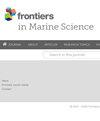南大洋颗粒物质的生物光学变异性
IF 3
2区 生物学
Q1 MARINE & FRESHWATER BIOLOGY
引用次数: 0
摘要
海洋中颗粒的组成和大小分布控制着它们的光学(散射和吸收)特性,以及一系列生物地球化学和生态过程。因此,它们提供了有关浮游海洋生态系统结构和功能的重要信息,可用于评估初级生产、颗粒沉降和碳封存。由于南大洋(SO)环境恶劣、位置偏远,对其微粒生物光学特性的观测和了解仍然很少。在此,我们结合两次研究航行的水文测量数据和自主剖面浮标(BGC-Argo)的实地测量数据,研究了颗粒生物光学特性以及几个重要的生态和光学变量之间的关系,即浮游植物叶绿素 a 浓度(Chl)、颗粒吸收系数(ap)、颗粒后向散射系数(bbp)和颗粒有机碳浓度(POC)。在 SO 最清澈的水域(Chl< 0.2 mg m-3)中,我们发现非藻类颗粒(NAP)对 442 纳米波长的吸收有显著贡献,是浮游植物吸收的 10 倍。这使得那里的微粒生物光学特性与典型的海洋情况 1 海水有明显不同。匹配分析证实了更大的 NAP 吸收对从卫星海洋颜色观测中获取 Chl 的影响。对于 Chl > 0.2 mg m-3 的水域,在 SO 和温带水域之间没有观察到显著差异。我们的研究结果还表明,从 Chl 或 bbp 预测浮游植物碳具有一致性,表明这两种方法都适用于 SO。本文章由计算机程序翻译,如有差异,请以英文原文为准。
Bio-optical variability of particulate matter in the Southern Ocean
The composition and size distribution of particles in the ocean control their optical (scattering and absorption) properties, as well as a range of biogeochemical and ecological processes. Therefore, they provide important information about the pelagic ocean ecosystem’s structure and functioning, which can be used to assess primary production, particle sinking, and carbon sequestration. Due to its harsh environment and remoteness, the particulate bio-optical properties of the Southern Ocean (SO) remain poorly observed and understood. Here, we combined field measurements from hydrographic casts from two research voyages and from autonomous profiling floats (BGC-Argo) to examine particulate bio-optical properties and relationships among several ecologically and optically important variables, namely the phytoplankton chlorophyll a concentration (Chl), the particulate absorption coefficient (ap ), the particulate backscattering coefficient (b bp ), and the particulate organic carbon (POC) concentration. In the clearest waters of the SO (Chl < 0.2 mg m−3 ), we found a significant contribution to absorption by non-algal particles (NAP) at 442 nm, which was up to 10 times greater than the absorption by phytoplankton. This makes the particulate bio-optical properties there remarkably different from typical oceanic case 1 water. A matchup analysis confirms the impact of this larger NAP absorption on the retrieval of Chl from satellite ocean colour observations. For waters with Chl > 0.2 mg m−3 , no significant differences are observed between the SO and temperate waters. Our findings also demonstrate consistency in predicting phytoplankton carbon from either Chl or b bp , suggesting that both methods are applicable in the SO.
求助全文
通过发布文献求助,成功后即可免费获取论文全文。
去求助
来源期刊

Frontiers in Marine Science
Agricultural and Biological Sciences-Aquatic Science
CiteScore
5.10
自引率
16.20%
发文量
2443
审稿时长
14 weeks
期刊介绍:
Frontiers in Marine Science publishes rigorously peer-reviewed research that advances our understanding of all aspects of the environment, biology, ecosystem functioning and human interactions with the oceans. Field Chief Editor Carlos M. Duarte at King Abdullah University of Science and Technology Thuwal is supported by an outstanding Editorial Board of international researchers. This multidisciplinary open-access journal is at the forefront of disseminating and communicating scientific knowledge and impactful discoveries to researchers, academics, policy makers and the public worldwide.
With the human population predicted to reach 9 billion people by 2050, it is clear that traditional land resources will not suffice to meet the demand for food or energy, required to support high-quality livelihoods. As a result, the oceans are emerging as a source of untapped assets, with new innovative industries, such as aquaculture, marine biotechnology, marine energy and deep-sea mining growing rapidly under a new era characterized by rapid growth of a blue, ocean-based economy. The sustainability of the blue economy is closely dependent on our knowledge about how to mitigate the impacts of the multiple pressures on the ocean ecosystem associated with the increased scale and diversification of industry operations in the ocean and global human pressures on the environment. Therefore, Frontiers in Marine Science particularly welcomes the communication of research outcomes addressing ocean-based solutions for the emerging challenges, including improved forecasting and observational capacities, understanding biodiversity and ecosystem problems, locally and globally, effective management strategies to maintain ocean health, and an improved capacity to sustainably derive resources from the oceans.
 求助内容:
求助内容: 应助结果提醒方式:
应助结果提醒方式:


